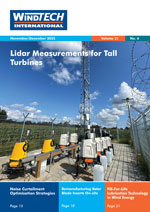- Category: Articles
Reducing Structural Mass in Direct-Drive Permanent Magnet Electrical Generators
 Direct-drive wind turbines offer the potential for high efficiency and reliability but they require large and heavy electrical generators. Large electrical machines require significant structural material to maintain the small airgap clearance between rotor and stator. This structural mass can be modelled, and optimised by either choosing lightweight materials or by adding to the airgap stiffness or using air-cored topologies. A new topology (the ‘E-generator') combines the structural and active material in a ‘C' core module, which can be supported lightly for high torque machines.
Direct-drive wind turbines offer the potential for high efficiency and reliability but they require large and heavy electrical generators. Large electrical machines require significant structural material to maintain the small airgap clearance between rotor and stator. This structural mass can be modelled, and optimised by either choosing lightweight materials or by adding to the airgap stiffness or using air-cored topologies. A new topology (the ‘E-generator') combines the structural and active material in a ‘C' core module, which can be supported lightly for high torque machines.By Alasdair McDonald, Institute for Energy Systems, UK
.- Category: Articles
New Techniques and Criteria for the Design of Structural Components
One of the issues to be solved to make upscaling of wind turbines a reality is the design of improved structural components. Since finite element computations are already in widespread use in the industry, the aim is now to find new simulation tools and improved failure criteria which could be used to design lighter but stiffer and stronger components. The application of fracture mechanics in the analysis of composite materials is a relatively new trend, which provides solutions for the former objectives. The aerospace industry has already proposed new criteria that try to improve the accuracy offered by the usual failure criteria by using fracture mechanics to analyse local phenomena such as fibre kinking and in situ effects. Other fracture mechanics related techniques offer the possibility to consider mechanical degradation caused by delamination and loss of adhesion. This article describes these new criteria and techniques. These are ready to use and will be employed regularly in the wind energy industry in the upcoming years.
By Daniel Trias, National Renewable Energies Centre (CENER), Spain
.- Category: Articles
A New Look at the Merits of Vertical Axis Wind Turbines
 For many years the Dutch style of Horizontal Axis Wind Turbine (HAWT) has dominated the market, but now, for a number of reasons, developers and investors alike are taking another look at what Vertical Axis Wind Turbines (VAWT) can offer.
For many years the Dutch style of Horizontal Axis Wind Turbine (HAWT) has dominated the market, but now, for a number of reasons, developers and investors alike are taking another look at what Vertical Axis Wind Turbines (VAWT) can offer.- Category: Articles
Smarter and Faster Blade Testing
 The last decade has seen a remarkable growth in the rated power of wind turbines throughout the world, particularly in Europe, with a 170m diameter 10MW turbine thought technically feasible by 2015. It has been an increasing challenge for the wind turbine industry to meet these technical requirements and in doing so the industry has employed a large amount of innovation in the detailed use of materials, design, analysis and testing. In this article, the authors propose a new damage tolerance methodology for the design and testing of wind turbine blades. This has the potential to radically reduce the test programme requirements for large wind turbine blades.
The last decade has seen a remarkable growth in the rated power of wind turbines throughout the world, particularly in Europe, with a 170m diameter 10MW turbine thought technically feasible by 2015. It has been an increasing challenge for the wind turbine industry to meet these technical requirements and in doing so the industry has employed a large amount of innovation in the detailed use of materials, design, analysis and testing. In this article, the authors propose a new damage tolerance methodology for the design and testing of wind turbine blades. This has the potential to radically reduce the test programme requirements for large wind turbine blades.By Josef Kryger Tadich and Jakob Wedel-Heinen, DNV Wind Energy, Denmark
- Category: Articles
A Decade of Wind Farm Software
 A summary is given of some of the developments that have taken place over the last 10 years in the field of wind farm software. The visualisation side of the development process has advanced the most and now sees the introduction of 3D landscape tools.
A summary is given of some of the developments that have taken place over the last 10 years in the field of wind farm software. The visualisation side of the development process has advanced the most and now sees the introduction of 3D landscape tools.By Alan Harris, ReSoft Ltd, UK
- Category: Articles
The Concept of the PrimAero Wind Sensor
 Have you ever seen standard meteorological wind measurement devices like wind vanes or anemometers on aeroplanes? Certainly not. The most important reason is that the measurement bases would be wrong. When you compare measurement devices, the most obvious differences are the measurement principles they are based on (i.e. the use of laser, sound waves or other techniques to detect a signal and the physics behind this). But this is only one aspect. Even more interesting than 'how' a device works is 'what' it measures. Clarity about the measurement target is the most important factor to consider for any measurement device. From this point of view, the PrimAero wind sensor is unique for wind measurement on wind turbines because it not only measures the wind speed but also the wind pressure as a whole.
Have you ever seen standard meteorological wind measurement devices like wind vanes or anemometers on aeroplanes? Certainly not. The most important reason is that the measurement bases would be wrong. When you compare measurement devices, the most obvious differences are the measurement principles they are based on (i.e. the use of laser, sound waves or other techniques to detect a signal and the physics behind this). But this is only one aspect. Even more interesting than 'how' a device works is 'what' it measures. Clarity about the measurement target is the most important factor to consider for any measurement device. From this point of view, the PrimAero wind sensor is unique for wind measurement on wind turbines because it not only measures the wind speed but also the wind pressure as a whole.By Klaus Ritzinger, Head of Research & Development, IXIST Messtechnik, Germany
- Category: Articles
Simulation of Electric Field Distributions Caused by the Lightning Leader
 Based on the lightning leader model of Cooray et al., the electric field distribution on a wind turbine induced by the leader has been simulated using the Finite Element Method (FEM). Because of its dimensions and complexity, the wind turbine has been simplified to its lightning protection system and by simulating only one blade. The derived electric field distribution has then been used as input for a detailed blade-tip model. The detailed model can be used to analyse the influence of the down-conductor shape on the electric breakdown emergence.
Based on the lightning leader model of Cooray et al., the electric field distribution on a wind turbine induced by the leader has been simulated using the Finite Element Method (FEM). Because of its dimensions and complexity, the wind turbine has been simplified to its lightning protection system and by simulating only one blade. The derived electric field distribution has then been used as input for a detailed blade-tip model. The detailed model can be used to analyse the influence of the down-conductor shape on the electric breakdown emergence.By Bastian Lewke and Josef Kindersberger, Technische Universität München, Germany










